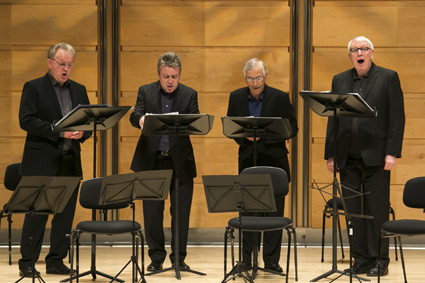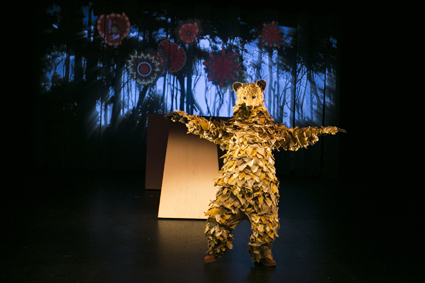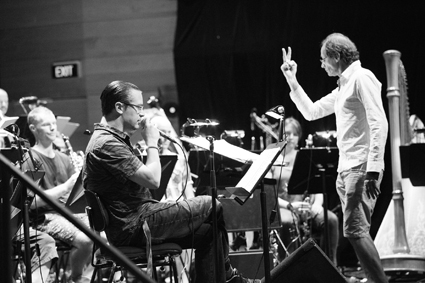Music’s mysterious magic
Keith Gallasch: Sydney Festival, part 2

Hilliard Ensemble
photo Jamie Williams
Hilliard Ensemble
The Hilliard Ensemble
My first experience of a live performance by the UK’s The Hilliard Ensemble was a thrill: the singing felt and looked simply natural—lucid, warmly un-churchy, devoid of over articulation and forced projection in the responsive acoustic of the University of Sydney’s Great Hall.
I quickly became engrossed in the program’s blend of drama and reflection and the sacred and the secular, and a sense of discovery, not least the 13th century Viderunt Omnes by Perotin (rich in swelling wordless chanting, a contrasting jaunty performance of the text and a return to the mesmeric opening sounds), a set of traditional Armenian sacred songs (arranged by Komitas) seemingly in the Orthodox tradition but deeply infused with a distinctively local character (which is heard also as an influence in Marcus Whle’s score for Shaun Parker and Company’s dance work Am I), and three new folk-inspired songs by Hosokawa, which the ensemble only received on arrival in Australia. Linked by a humming motif, the songs slip organically between Western and Japanese modes with supple vocal glides, warbles and melodic twists out of folk, Bunraku and Kabuki traditions.
While the madrigals and liturgical pieces were predictably fine, revealing a great variety of forms and innovations, I was taken by the inherent theatricality of several of the works. Estonian Veljo Tormis’ Kullervo’s Message is a vigorously sung narrative taken from Finland’s Kalevala epic, hauntingly anchored with the repeated whispering of the hero’s name. Arvo Part’s And One of the Pharisees… and Most Holy Mother of God have a surprisingly intense theatricality when performed live. The latter is stunningly spare, solely repeating the phrase “Most Holy Mother of God, Save Us” 17 times with engrossing harmonic richness and subtle rhythmic variations making the prayer dramatically felt.
The concert’s encore was the very funny entr’acte about ‘nobodies’ (based on a Kafka story, Excursion to the Mountain) from a Heiner Goebbels’ music theatre work titled I went to the house but did not enter, in which the ensemble had become actor-singers in 2007—and clearly quite proudly so, if now apparently amused at getting through the piece. Sadly, this concert was one of the ensemble’s last—a founding member had been part of the group for 40 years, the others 20, making profound connections between musical traditions old and new, lustrously sung.

The Piper, My darling Patricia
photo Jamie Williams
The Piper, My darling Patricia
My Darling Patricia, The Piper
The common notion of tragedy is about lives cut short, especially those of children. The traditional tale of the Pied Piper of Hamelin entails the disappearance of all the children of a town, but the ambiguities provided by the variety of endings we have inherited make the tale more mysterious than tragic, if nonetheless inherently alarming.
My Darling Patricia’s The Piper, the first of two festival productions about the Pied Piper (the second was Sydney Camber Opera’s Into the Little Hill), presented an ambitious version of the tale apparently inspired by the Ted Hughes’ account. Although enthusiastically received by reviewers and audiences, I thought it over written and the narrative unnecessarily complicated. I was sometimes as nonplussed as the children of various ages around me.
Before the show proper commences, head-phoned child and adult volunteers respond to movement instructions familiarising themselves with the performing space. Once underway, they become the townspeople of Hamelin and the children are later lead away by the Piper. The story is told by an off-stage narrator (a reassuring velvet voiced Clare Grant) while large-scale projected animations by Sam James establish a sense of place (a heavily industrialised city, bug life close-ups of nature and surrounding conifer forests, although the narration slips in eucalypts as well). Unattractive white mobile ramps vary the stage space while deft puppeteering (later shared with the volunteer performers) provides humour in the form of the dextrous rats plaguing the city.
The Piper arrives: a glorious, autumnally golden bear—a she bear, says the narrator. First up, the non-speaking bear-cum-Piper amusingly mimes being a multi-instrumentalist, but that’s gotten quickly out of the way. Her talent is as a dancer: Ghenoa Gela moves with a delightful bear-like sway on hind feet. So what is going to seduce the children of Hamelin? The bear doesn’t pipe so is it the dancing? It’s a palpable gap and left me wondering. Could the pre-show ‘induction’ have included a simple dance step for the children, so when the bear dances them away it can be done with conviction in what should be a delightful but equally chilling moment. After all the Bear appears to seduce the rats in a dance with lengths of blue silk. In the meantime, the narrator has bewilderingly announced, If I hear right, that she is the otherwise non-speaking Bear/Piper.
The most bracing moments in The Piper include the Bear’s drowning of the rats, aided by the volunteers waving the blue silk cloth of the roaring river, and then her raging against the Mayor’s cheating her of her reward. She stands up high against a cloud swirling storm, gesturing angrily: nature intent on vengeance. After that, the children are taken away, eventually returning, partying with the bear, although the narrator is not so sure about their fate: maybe, she says, the children are “battling cane toads and other pests” with the bear. But what we see is of course more reassuring. There are many endings to the old tale: good (relocation to start a new life), bad (the Piper as plague) and ugly (the Piper as paedophile). This version is a muddle, lacking My Darling Patricia’s usual clarity of purpose and integrated design magic. The participatory goal and the appeal of the bear suggest that a more lucid Piper has potential.

Ensemble Offspring with Lee Ranaldo and Mike Patton, Sydney Festival 2014
photo Chris Frape
Ensemble Offspring with Lee Ranaldo and Mike Patton, Sydney Festival 2014
Lee Renaldo, Mike Patton, Ensemble Offspring
In this double bill, Ensemble Offspring became a potent chamber orchestra, conducted with vigour and precision by Roland Peelman. Mike Patton, welcomed by a screaming audience, delivered his account of Berio’s Laborintus II with basso spoken and screamed texts with loudhailer and considerable verve, accompanied by the Song Company, its female member providing some of this fierce composition’s most beautiful, melancholy sounds in Part I, while the Ensemble Offspring orchestra excelled, especially in the quickfire transition to a demented big band uproar. Unfortunately there were no surtitles and a predictable rag bag of video images (forests, data map, speeding cars, experimental film scribbling) in Part II added nothing. But the interplay between the words of Dante, Sanguineti, Eliot, Pound and the Bible—as sound—with the acoustic instrumentation and electronic score was exhilarating and, in the end, gently seductive.
Also on the program was Lee Ranaldo’s Hurricane Transcriptions, a response to Hurricane Sandy (in its wake he had limited supplies and no electricity for a week). Although not intended as a literal recounting of being hit by a hurricane, the work nonetheless emerged from sharp cello snaps, whisperings and a deepening pulse into a subsequent musical storm in two waves, variously replete with electric guitar bowing and then chiming against frantic strings, siren moans and a hammered metal sheet. Unfortunately, the several songs that Renaldo wove into the work, while passable as stand-alones, sounded naïve, the accompaniment suddenly conventional and at odds with the rest of the composition’s ambient fascination. Nonetheless this moody, sometimes quite disturbing work made its mark in what was a standout festival concert.
–
2014 Sydney Festival: The Hilliard Ensemble: A Hilliard Songbook, The Great Hall, University of Sydney, 15 Jan 15; My Darling Patricia, The Piper, Carriageworks, 9-19 Jan; Hurricane Transcriptions/Laborintus II, Lee Ranaldo, Mike Patton, Ensemble Offspring, Song Company, City Recital Hall, 16 Jan
RealTime issue #119 Feb-March 2014 pg. web






